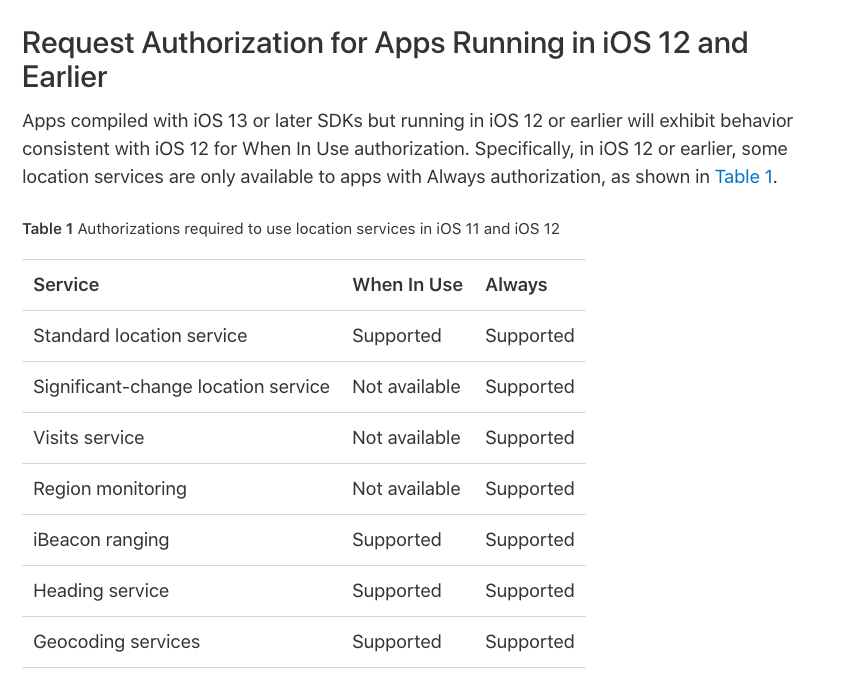iOS定位許可權請求時易犯的錯誤小結
起因
使用者群反饋app可能請求了不合適的定位許可權:始終定位。

看到這個截圖,根據經驗判斷可能是後臺定位功能導致可能不得不請求始終定位許可權。再加上之前提交稽核時,蘋果要求在plist檔案中新增NSLocationAlwaysAndWhenInUseUsageDescription和NSLocationAlwaysUsageDescription鍵值對。猜測可能是對某些點的理解混淆了,因為這種使用者體驗的確不好。
解決思路
因為此專案是前同事遺留程式碼,自從接手後迭代次數比較有限。於是計劃根據以下步驟進行排查和驗證:
- 查現有程式碼和plist檔案
- 查官方文件
- 改工程程式碼
- 提交稽核,檢視郵件提醒
- app退入後臺,檢視定位資訊是否輸出
查plist檔案和許可權請求程式碼
plist檔案
以下鍵都已加入:
NSLocationAlwaysUsageDescription
NSLocationWhenInUseUsageDescription
NSLocationAlwaysAndWhenInUseUsageDescription許可權請求程式碼
全域性搜尋request,找到定位許可權請求程式碼,發現
if ([_locationManager respondsToSelector:@selector(requestWhenInUseAuthorization)]) { [_locationManager requestAlwaysAuthorization]; }
查官方文件
plist檔案配置
NSLocationAlwaysUsageDescription
Discussion
Use this key if your iOS app accesses location information in the background, and you deploy to a target earlier than iOS 11. In that case, add both this key and NSLocationAlwaysAndWhenInUseUsageDescription to your app’s Info.plist file with the same message. Apps running on older versions of the OS use the message associated with NSLocationAlwaysUsageDescription, while apps running on later versions use the one assocated with NSLocationAlwaysAndWhenInUseUsageDescription.
If your app only needs location information when in the foreground, use NSLocationWhenInUseUsageDescription instead. For more information, see Choosing the Authorization Level for Location Services.
If you need location information in a macOS app, use NSLocationUsageDescription instead.
Important
This key is required if your iOS app uses APIs that access the user’s location at all times and deploys to targets earlier than iOS 11.NSLocationWhenInUseUsageDescription
Discussion
Use this key if your iOS app accesses location information only when running in the foreground. If your app needs location information when in the background, use NSLocationAlwaysAndWhenInUseUsageDescription instead. For more information, see Choosing the Authorization Level for Location Services.
If you need location information in a macOS app, use NSLocationUsageDescription instead.
Important
This key is required if your iOS app uses APIs that access the user’s location information while the app is running in the foreground.NSLocationAlwaysAndWhenInUseUsageDescription
Discussion
Use this key if your iOS app accesses location information while running in the background. If your app only needs location information when in the foreground, use NSLocationWhenInUseUsageDescription instead. For more information, see Choosing the Authorization Level for Location Services.
If you need location information in a macOS app, use NSLocationUsageDescription instead. If your iOS app deploys to versions earlier than iOS 11, see NSLocationAlwaysUsageDescription.
Important
This key is required if your iOS app uses APIs that access the user’s location information at all times.
對比可知:
- 如果app需要前臺執行定位許可權,需要配置NSLocationWhenInUseUsageDescription;
- 如果app需要後臺執行定位許可權,需要配置NSLocationAlwaysAndWhenInUseUsageDescription;如果適配iOS11之前版本,還需要配置NSLocationAlwaysUsageDescription
這幾種鍵的區別主要在於區分app 前後臺執行 時的許可權配置。
許可權請求程式碼
requestAlwaysAuthorization
When the user grants “Always” authorization to your app, your app can start any of the available location services while your app is running in the foreground or background. In addition, services that allow your app to be launched in the background continue to do so.
Important
Requesting “Always” authorization is discouraged because of the potential negative impacts to user privacy. You should request this level of authorization only when doing so offers a genuine benefit to the user.
requestWhenInUseAuthorization
You must call this method or the requestAlwaysAuthorization()method prior to using location services. If the user grants “when-in-use” authorization to your app, your app can start most (but not all) location services while it is in the foreground. (Apps cannot use any services that automatically relaunch the app, such as region monitoring or the significant location change service.) When started in the foreground, services continue to run in the background if your app has enabled background location updates in the Capabilities tab of your Xcode project. Attempts to start location services while your app is running in the background will fail. The system displays a location-services indicator in the status bar when your app moves to the background with active location services.
官方建議:
The type of authorization (“when-in-use” or “always”) that you request determines which location services your app can access and when it can use them:
When-in-use authorization. Your app can use most services but cannot use services that automatically relaunch the app. Your app must always start services while running in the foreground. If you enable the background location capability for your app, a suspended app will wake in the background to handle location events. However, if your app is not running, it will not be launched.
Always authorization. Your app can use all location services, and it can start those services from either the foreground or the background. If a location-related event occurs when your app is not running, the system launches your app and delivers the event.
官方更詳細說明:
https://developer.apple.com/documentation/corelocation/choosing_the_location_services_authorization_to_request
改工程程式碼
- 保持plist配置不變
- 修復請求方法:
if ([_locationManager respondsToSelector:@selector(requestWhenInUseAuthorization)]) {
[_locationManager requestWhenInUseAuthorization];
}提交稽核,檢視郵件提醒
新增version,打包上傳,檢視郵件提醒:並未提及定位許可權有何問題。
app退入後臺,檢視定位資訊是否輸出
為驗證app退到後臺依舊可以定位,故實測退到後臺後,gps回撥方法中log是否持續輸出,結果:會!
結論
plist許可權配置的定義和通過程式碼請求許可權不是絕對的一一對應關係,容易被誤解,前同事也是在這個地方混淆了。這也是本bug出現的根本原因。
以後遇到類似易混淆概念,還是查好多篇相關官方文件,並充分理解後再寫程式碼比較好。關於本知識點,網上有的教程可能會混淆,請注意鑑別。
- 讓我們杜絕淺嘗輒止,追求精益求精!

